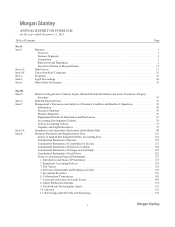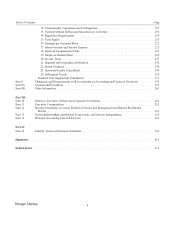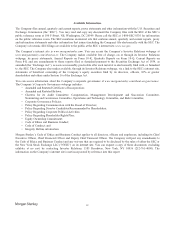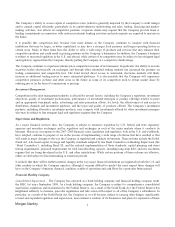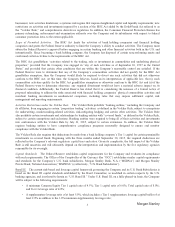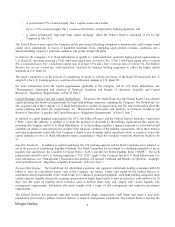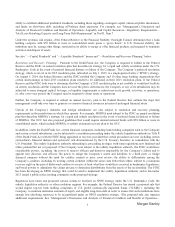Morgan Stanley 2015 Annual Report Download - page 7
Download and view the complete annual report
Please find page 7 of the 2015 Morgan Stanley annual report below. You can navigate through the pages in the report by either clicking on the pages listed below, or by using the keyword search tool below to find specific information within the annual report.
Part I
Item 1. Business.
Overview.
Morgan Stanley is a global financial services firm that, through its subsidiaries and affiliates, advises, and originates, trades,
manages and distributes capital for, governments, institutions and individuals. Morgan Stanley was originally incorporated
under the laws of the State of Delaware in 1981, and its predecessor companies date back to 1924. The Company is a
financial holding company regulated by the Board of Governors of the Federal Reserve System (the “Federal Reserve”)
under the Bank Holding Company Act of 1956, as amended (the “BHC Act”). The Company conducts its business from its
headquarters in and around New York City, its regional offices and branches throughout the U.S. and its principal offices in
London, Tokyo, Hong Kong and other world financial centers. As of December 31, 2015, the Company had 56,218
employees worldwide. Unless the context otherwise requires, the terms “Morgan Stanley,” the “Company,” “we,” “us” and
“our” mean Morgan Stanley together with its consolidated subsidiaries.
Financial information concerning the Company, its business segments and geographic regions for each of the 12 months
ended December 31, 2015 (“2015”), December 31, 2014 (“2014”) and December 31, 2013 (“2013”) is included in the
consolidated financial statements and the notes thereto in “Financial Statements and Supplementary Data” in Part II, Item 8.
Business Segments.
The Company is a global financial services firm that maintains significant market positions in each of its business
segments—Institutional Securities, Wealth Management and Investment Management. Through its subsidiaries and affiliates,
the Company provides a wide variety of products and services to a large and diversified group of clients and customers,
including corporations, governments, financial institutions and individuals. Additional information related to the Company’s
business segments, respective clients, and products and services provided is included under “Management’s Discussion and
Analysis of Financial Condition and Results of Operations” in Part II, Item 7.
Competition.
All aspects of the Company’s businesses are highly competitive, and the Company expects them to remain so. The Company
competes in the U.S. and globally for clients, market share and human talent. Operating within the financial services industry
on a global basis presents, among other things, technological, risk management, regulatory and other infrastructure
challenges that require effective resource allocation in order for the Company to remain competitive. The Company’s
competitive position depends on its reputation and the quality and consistency of its long-term investment performance. The
Company’s ability to sustain or improve its competitive position also depends substantially on its ability to continue to attract
and retain highly qualified employees while managing compensation and other costs. The Company competes with
commercial banks, brokerage firms, insurance companies, electronic trading and clearing platforms, financial data
repositories, sponsors of mutual funds, hedge funds and private equity funds, energy companies and other companies offering
financial or ancillary services in the U.S., globally and through the internet. In addition, restrictive laws and regulations
applicable to certain U.S. financial services institutions, such as Morgan Stanley, which may prohibit the Company from
engaging in certain transactions and impose more stringent capital and liquidity requirements, can put the Company at a
competitive disadvantage to competitors in certain businesses not subject to these same requirements. See also
“—Supervision and Regulation” below and “Risk Factors” in Part I, Item 1A.
Institutional Securities and Wealth Management.
The Company’s competitive position for its Institutional Securities and Wealth Management business segments depends on
innovation, execution capability and relative pricing. The Company competes directly in the U.S. and globally with other
securities and financial services firms and broker-dealers and with others on a regional or product basis. Additionally, there is
increased competition driven by established firms as well as the emergence of new firms and business models competing for
the same clients and assets or offering similar products and services.
1



